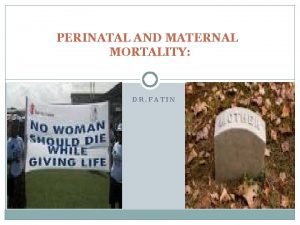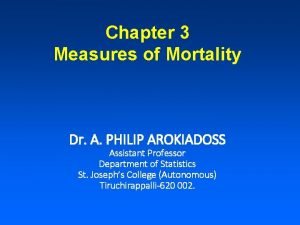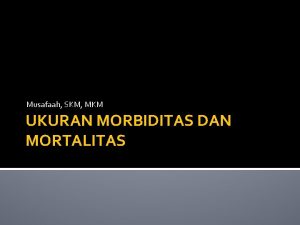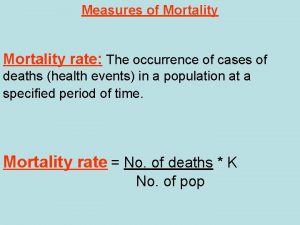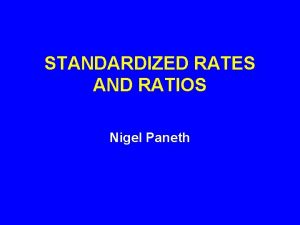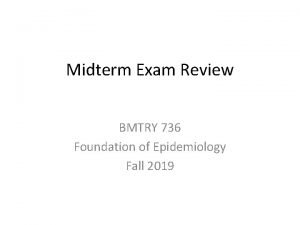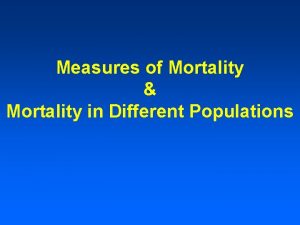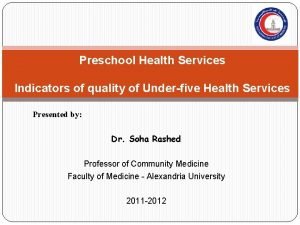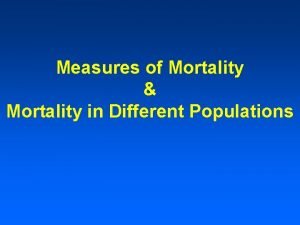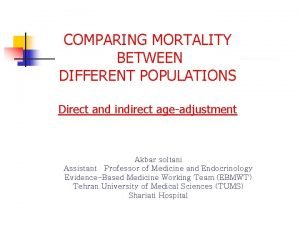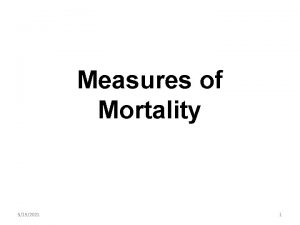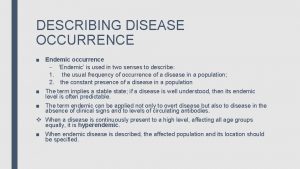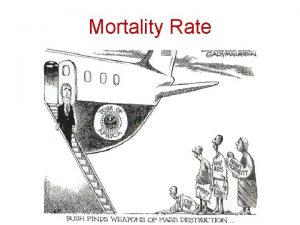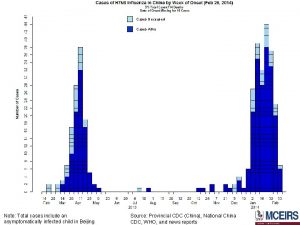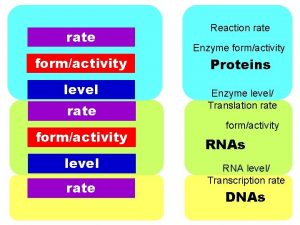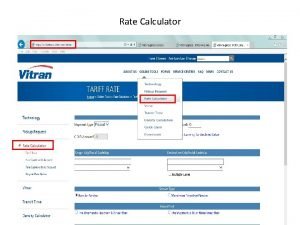Measures of Mortality rate The occurrence of cases




















- Slides: 20

Measures of Mortality rate: The occurrence of cases of deaths (health events) in a population at a specified period of time. Mortality rate = No. of deaths * K No. of pop.

Crude mortality rate (crude death rate) The crude mortality rate is the mortality rate from all causes of death for a population. For 10 n, we use 1, 000 or 100, 000. Crude M. R. = No. of deaths No. of pop. *K

Category-specific mortality rate 1. Age specific Mortality rate: An age-specific mortality rate is a mortality rate limited to a particular age group. The numerator is the number of deaths in that age group; the denominator is the number of persons in that age group in the population. Some specific types of agespecific mortality rates are neonatal, post-neonatal, and infant mortality rates.

2. Sex specific Mortality rate A sex-specific mortality rate is a mortality rate among either males or females. Both numerator and denominator are limited to the one sex. 3. Race specific Mortality rate A race-specific mortality rate is a mortality rate limited to a specified racial group. Both numerator and denominator are limited to the specified race.

Combinations of specific mortality rates Mortality rates can be further refined to combinations that are cause-specific, age-specific, sex-specific, and/or race-specific. Category specific M. R. = No. of cases of a category No. of pop. of that category *K

Cause-specific mortality rate The cause-specific mortality rate is the mortality rate from a specified cause for a population. The numerator is the number of deaths attributed to a specific cause. The denominator remains the size of the population at the midpoint of the time period. For 10 n, we use 100, 000. Cause specific mortality rate= No. of deaths assigned to a specific cause * 105 Mid-year population

Proportionate mortality Describes the proportion of deaths in a specified population over a period of time attributable to different causes. Each cause is expressed as a percentage of all deaths, and the sum of the causes must add to 100%. These proportions are not mortality rates, since the denominator is all deaths, not the population in which the deaths occurred. For a specified population over a specified period. PM= No. of deaths assigned to a specific cause * 105 Total No. of deaths from all causes

Age-adjusted mortality rates Often, we want to compare the mortality experience of different populations. However, since mortality rates increase with age, a higher mortality rate in one population than in another may simply reflect that the first population is older than the second. Statistical techniques are used to adjust or standardize the rates in the populations to be compared which eliminates the effect of different age distributions in the different populations. Mortality rates computed with these techniques are called age-adjusted or age-standardized mortality rates. =O/E O = Actual No. of deaths in a pop. E= Expected No. of deaths in a pop. MR (of a standard pop) = E / MYP (standardized population)

Infant mortality rate IMR is one of the most commonly used measures for comparing health services among nations. The numerator is the No. of deaths among children under 1 year of age reported during a given time period, usually a calendar year. The denominator is the No. of live births reported during the same time period. IMR is usually expressed per 1, 000 live births. IMR = No. of deaths under 1 year of age No. of live births during the same period * 1000

Is the infant mortality rate a proportion? Technically, it is a ratio but not a proportion. Consider the Iraqi IMR for 1988. In 1988, 38, 910 infants died and 3. 9 million children were born, for an IMR of 9. 95 per 1, 000. Undoubtedly, some of these deaths occurred among children born in 1987, but the denominator includes only children born in 1988.

Neonatal mortality rate The neonatal period is defined as the period from birth up to but not including 28 days. The numerator of the neonatal mortality rate therefore is the No. of deaths among children under 28 days of age during a given time period. The denominator of the neonatal mortality rate, like that of the infant mortality rate, is the No. of live births reported during the same time period. The NMR is usually expressed per 1, 000 live births. NMR = No. of deaths under 28 days of age No. of live births during the same period * 1000

Post-neonatal mortality rate The post-neonatal period is defined as the period from 28 days of age up to but not including 1 year of age. The numerator of the post-NMR therefore is the No. of deaths among children from 28 days up to but not including 1 year of age during a given time period. The denominator is the No. of live births reported during the same time period. The post-NMR is usually expressed per 1, 000 live births. Post NMR = No. of deaths from 28 days-1 year of age No. of live births during the same period * 1000

Maternal Mortality rate The maternal mortality rate is really a ratio used to measure mortality associated with pregnancy. The numerator is the No. of deaths assigned to causes related to pregnancy during a given time period. The denominator is the number of live births reported during the same time period. Because maternal mortality is much less common than infant mortality, the MMR is usually expressed per 100, 000 live births. MMR = No. of deaths assigned to preg. related causes* 100000 No. of live births during the same period

Death-to-case ratio The death-to-case ratio is the No. of deaths attributed to a particular disease during a specified time period divided by the number of new cases of that disease identified during the same time period. The figures used for the numerator and denominator must apply to the same population. The deaths in the numerator are not necessarily included in the denominator, however, because some of the deaths may have occurred in persons who developed the disease before the specified period. No. of deaths assigned to a specific disease * 100 No. of new cases of that disease at the same period

Case fatality rate The case-fatality rate is the proportion of persons with a particular condition (cases) who die from that condition. CFR= No. of cause-specific deaths among incident cases *100 No. of incident cases


Years of Potential Life Lost and YPLL Rate YPLL is a measure of the impact of premature mortality on a population. It is the sum of the differences between some predetermined end point and the ages of death for those who died before that end point. The two most commonly used end points are age 65 years and average life expectancy. Because of the way YPLL is calculated, it gives more weight to a death the earlier it occurs.

Calculating YPLL from a line listing 1. Eliminate the records of all persons who died at or after the end point (e. g. , age 65 years). 2. For each person who died before the end point, identify that individual’s YPLL by subtracting the age at death from the end point. 3. Sum the YPLL’s.

Calculating YPLL from a frequency distribution 1. Ensure that age groups break at the end point (e. g. , age 65 years). Eliminate all age groups older than the end point. 2. For each age group younger than the end point, identify the midpoint of the age group midpoint = Age group' s youngest age in years + oldest age + 1 2 3. For each age group younger than the end point, identify that age group’s YPLL by subtracting the midpoint from the end point. 4. Calculate age-specific YPLL by multiplying the age group’s YPLL times the number of persons in that age group. 5. Sum the age-specific YPLL’s.

Years of Potential Life Lost Rate represents years of potential life lost per 1, 000 population below the age of 65 years (or below the average life expectancy). YPLL rates should be used to compare premature mortality in different populations, since YPLL does not take into account differences in population sizes. YPLL rate = Years of potential life lost * 10 n Population under age 65 years
 Infant mortality rate formula
Infant mortality rate formula Perinatal mortality rate
Perinatal mortality rate Ap human geography unit 2
Ap human geography unit 2 Age adjusted mortality rate definition
Age adjusted mortality rate definition Morbiditas dan mortalitas adalah
Morbiditas dan mortalitas adalah Sex specific mortality rate
Sex specific mortality rate Mortality formula
Mortality formula Disease specific mortality rate formula
Disease specific mortality rate formula An epidemiologic survey of roller skating injuries
An epidemiologic survey of roller skating injuries Death rate formula
Death rate formula Infant mortality rate formula
Infant mortality rate formula Imr formula
Imr formula Neonatal mortality rate formula
Neonatal mortality rate formula Age adjusted mortality rate definition
Age adjusted mortality rate definition Criminal cases vs civil cases
Criminal cases vs civil cases Repeated measures design vs independent measures design
Repeated measures design vs independent measures design Themes of the great gatsby
Themes of the great gatsby Examples of morality plays
Examples of morality plays Attributable mortality
Attributable mortality Morbidity
Morbidity Continuous mortality investigation
Continuous mortality investigation

